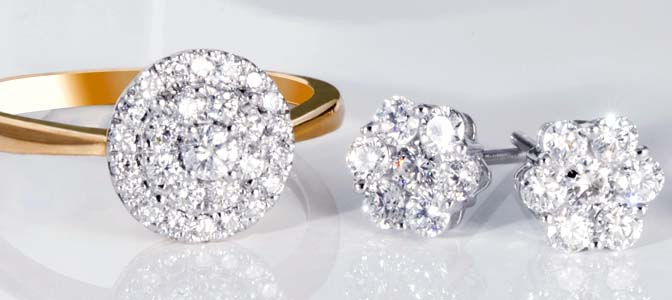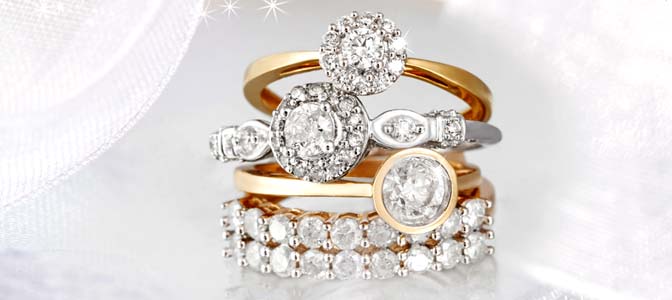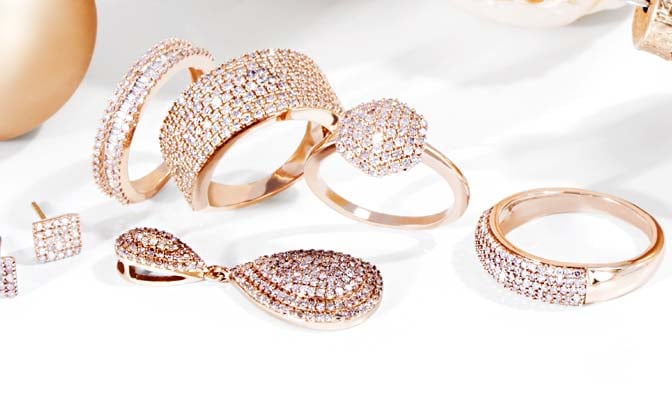
Introduction
Diamonds – the gorgeous spellbinding gems that everyone has heard of, if not owned. These spectacularly sparkling stones have been reigning the world of gemstones since as long as one can remember. They’re called best friends of women and have been the most coveted stones since an incredibly long while. The demand for these precious jewels doesn’t seem to be slimming down in foreseeable future, either. Seeing as to how popular they are, there’s still a lot that you surprisingly would not know about these stones. We have put all the relevant information together at a single source and brought you all you need to know about them. Read ahead to know more.
New Arrivals in Diamonds

Origin & Supply
Name of this stunning gemstones has been originated from the Greek word “adamas,” which translates into “the unconquerable.” This mostly has to do with their resilience and hard structure. Diamonds are made of strong carbon atoms, something much alike coals. Formed under the Earth, they are structured under extremely high pressure and temperatures. This also makes them the strongest naturally occurring gems among all! They’re absolutely clear to the eye and the perfect specimens lack any kind of clouding and/or inclusions.
The supply story of these gems is an interesting one. When initially found, they were believed to only exist in India and their demands sky-rocketed, too! It was in late years of 1725 that traces of these gorgeous gems were found in Brazil, and quite soon enough, it also became a popular mining and trading unit, however it didn’t have enough diamonds to feed the world’s demands. It was in the year 1866 that a child discovered sparkling stones on the banks of Orange River. In subsequent year 1871, a small hill called Colesberg Kopje unearthed more deposits. These findings alerted the connoisseurs of stones across the globe, and hence, the Kimberly Mines came to be. However, these large-sized mines exported so much diamond in bulk that elite no longer considered it a special or luxurious stone. Even with consistent efforts, the value of these gems had fallen to 50% by 1919.
In the recent year 1947, the phrase “a diamond is forever” was coined by DeBeers, which was in propaganda of the motion that only diamonds should be embedded in engagement rings. This campaign was a winning success and it increased the demand of the stone back, almost overnight!
As of the current market, gem-quality diamonds are extremely rare to come by. 75-80% of the roughage mined is used for industrial purposes, making saws or for drilling and grinding. Only about 20% gems mined are of gemstone quality, while only a slim 2% of the stone’s variety can be considered fit enough for investment.
How are Diamonds Mined?
These crystals are mined from deeper parts of the Earth. To extract them, there have been various techniques and operations involved. Three main ways of extracting diamonds have been mentioned below:
- Open Pit Mining: One of the most commonly found ways, this is when deep and open pits of the ground are dug up. The process starts by procuring offshore crystals in river streams, which are then followed to the mother source. A small part of the dug-up ore is then examined to determine the quality. If the stone is promising and of high-grade, large pits are formed, deep into the Earth. This is also called the Kimberly Mining and it has seriously damaging impact on the Earth.
- Alluvial Mining: Another technique applied to procure the stone is this. It is done on the offshore finding of the gem, like riverfronts and beaches. In these, walls or obstacles are drawn on the waterbodies to divert the flow. Once emptied, the Earth is then scoured to find diamonds. Heavy machinery like earthmovers and bulldozers make the job simpler.
- Offshore Mining: This is done when diamonds are found in marine bodies like seas. Sediments containing the rough stone are washed down the rivers into the coastlines. These are then collected employing different skills and techniques, like shallow water mining, deep sea mining, among other high-end operations.

Facts About Diamonds
- In the ancient legends, it was believed that the bows of Cupid were tipped with diamonds. This was also perhaps the oldest relation between these gems and love-related notions.
- Diamonds are considered to be among the oldest gemstones. They’re believed to date back millions and billions of years. They take even longer time to form, making them truly unique and understandably treasured.
- Legends and tales believed that diamonds were actually the tears shed by God. Some ancient Roman and Greek stories also say that these stones are actually splinters of falling stars, which fell on the Earth and became gems.
- As of the current market, most of these gems being extracted are heavily flawed. About 80% of the stones mined are being used for industrial purposes, like saws and grinding. From the remaining 20%, only about 2% can be considered valuable enough for investments. Rest can be worn as trendsetting jewellery.
- The structure of diamonds is the same as charcoal. In fact, you may find traces of the fine diamond dust or its nanoparticles in the flame, as suggested by Wuzong Zhou, professor of Chemistry at University of St. Andrews.
- Diamond birthstone was added to the list when it was curated back in the year 1912. It was assigned for the month of April and is believed to bring luck and joy to the people who are born during this month.
- It is extremely difficult to tell the difference between a diamond that has been created in lab and one that is naturally sourced. Even skilled gemmologists find it difficult. The differentiation has been made easy using machinery.
- Because of the tenacity and tough resilience of this gem, it was often seen to be associated with invincibility, courage, and power in the ancient times.
- Diamonds rank perfectly at 10 on the Mohs Scale of Hardness. This means that virtually nothing can break, fracture, or even scratch these stones. In fact, the only way of cutting and faceting a diamond is by using another diamond.
- The largest diamond known to have been mined is called The Cullinan Diamond. It weighs 1.33 pounds and 3106 carats! The stone was later cut into 9 large stones and about 100 smaller ones.

Properties of Diamonds
Diamonds have been the favourites of all, from as long as mankind can remember. The exuberantly rich gemstones have made their spot in the jewellery box of everyone! Most diamonds today have been used for the purpose of investments. This the reason why they need to reflect absolute perfection and bring the same high value as their price. Below are the 4 main factors that affect the grade of this beautiful gemstone.
- Colour: The colour of a sparkling diamond is of pivotal importance. Higher-priced and premium grade specimens have a clear and colourless make. They boast complete transparency with the absence of even tinge of hues. The price of a stone goes down as it gets more highlighted tinges of yellow or brown. However, this is not the case when the colour is intense. In fact, the price of rare blue diamonds or pink diamonds is significantly higher than the white ones, owing to their slim findings.
- Cut: Diamonds are the hardest substances known to the mankind. They’re the gems that rank a whopping 10 on the Mohs Scale Hardness, which makes them ace the ranks. This unique feature means that the only means of cutting a diamond is by using another similar gemstone to do it. That said, the cut of this stone is all about the faceting applied to it. Its sparkle will be the most effective and glittering when it features perfectly done faceting. One of the most treasured cuts of the stone is called “brilliant cut,” where it features a pointy end and that exclusive magazine-perfect shape.
- Clarity: Considering the current quality that is being mined, only a small portion of the roughage sourced has gemstone quality. Only about 20% of the stones mined are free of inclusions and clouding. The rest of considerably poor quality and cannot be used for jewellery designs. The Gemmological Institute of America has developed a scale that lets them evaluate the stone and identity the grade according to clarity. The gemstones that are free of inclusions or clouding are ranked the highest among all. The natural inclusions will always be found but stones lose value only if these inclusions affect the transparency of the specimen.
- Carat: Carat is weighing scale of gemstones. A carat an be recorded as one fifth of a gram. Carat weight of diamonds has a denting impact of the price of these stones, too. The price of your stone is more likely to fluctuate depending on its clarity and carat weight. With clear transparency and higher carat weight, the price of the gem will most possibly go up!

What to Remember While Buying Diamonds?
There is a lot that you need to keep in mind when you’re seeking to shop for the fanciest of these gems. These stones are usually available in a whole spectrum of hues, ranging in different price points, too. You need to know just how-to identity the true value of your stone.
- Set your budget. It is crucial that you know beforehand as to how much you plan on spending on a single diamond. In the market, you’ll come across a whole range of several different prices and types.
- Study as much as you can. Invest time in knowing more about the gemstone. Study the 4Cs of it and the factors that affect its quality. These factors are cut, colour, clarity, and carat. It depends primarily on these factors as to how high your stone is going to be priced. All 4Cs are explained above.
- Ask for certification. Diamonds are extremely valuable and high-priced gemstones. Every jeweller who is selling real stones will always have certificate that presents the authenticity of this gem. Always ask for this certification before you make the payment. This will also let you know all the details about your stone.
- Another important factor that is going to the affect the price of your jewellery is the metal you have picked. The setting of your gem in different premium metals also fluctuates its prices. If you’re picking platinum or gold, it is always going to be more expensive than silver, rhodium, or other plated metals.
- Learn about the different shapes of this stone. A diamond is available in a whole selection of different shapes and sizes and these have a direct effect on the price of the gem, too. If you don’t know much about the shapes, always opt for brilliant cut or cushion cut.
- Always study your gemstone closely. There are lots of different scales and grades of evaluating the colour and clarity of a diamond. It is needful that you know them. The highest priced variant will have a stunning white or absolutely colourless structure. It will also display no inclusions or specks, even under magnification.
- Diamond is the hardest and the most resilient crystal among all. It ranks perfect 10 on the Mohs Scale of Hardness, which means that virtually nothing can break or even scratch your stone. Keep this in mind when you’re investing in this jewel. Its imitations, on the other hand, are easy to break.
- Ask for treatment. Like all the other gemstones in the current circulating market, diamond too, undergoes some sort of treatment that enhances it clarity or colour. When you’re buying your stone, always ask the dealer about what treatment it has gone under. This treatment might affect the value of your stone, too.
- Ask if your diamond is man-made or natural. The origination of your stone will also have a strong effect on its prices. The naturally found and procured stones will always be more expensive than the lab-created ones.
- Study more about fluorescence. It is usually perceived as a flaw when evaluating stones and can reduce their price by a considerable percentage. However, in case of clear diamonds, this factor is seen as an advantage.
FAQ's
How to Tell If You Diamond Is Real?
Apart from its impressive hardness of 10 on the Mohs Scale of Hardness, there’s another quick test that lets you know if your diamond is real. You need to try fogging up the diamond with your breath and if the fog clears in under 2 seconds, it’s real. However, if it’s taking up to 4 seconds, it’s probably fake.
Can You Scratch A Diamond?
It’s extremely difficult to scratch the stone. It has a pretty resilient and strong structure, which protects it from getting abraded and fractured when in contact with impact. Only surfaces with more strength that it can cause damage to it.
Is It Good to Invest in Diamonds?
Yes, it’s a good idea to invest in diamonds. But that said, you need to keep in mind the different grades. Only the high-end and premium-grade diamonds will bring you return. Know more about the stone and see if it’s pure enough to get you proper returns.
Is Diamond A Healing Stone?
Yes, healers have believed that the sparkling stone harbours lots of powers. They believe that it is a powerful crystal that doesn’t need recharging. It is said to bring strength and endurance to the wearer. It is also believed to be associated with invincibility and fearlessness.
Is Diamond a Birthstone?
Yes, the diamond birthstone has been assigned for the month of April. It was added in the list, back in the year 1912. It is also believed that it shall bring happiness and luck to the people born during this month.
What’s the Quickest of Telling If You Diamond is Fake?
There’s a neat trick that let’s you instantly find out whether your stone is real or fake. You can place your diamond in a bowl of water. Real diamonds have a dense structure so they should sink to the bottom instantly. However, the cheaper imitations seem to float due to lighter density.
What is A Lab-Created Diamond?
As opposed to the naturally procured diamonds, lab-created variants are synthetically created. They have the same chemical as well as physical properties as of a real stone. These are usually called Cubic Zirconia.








































